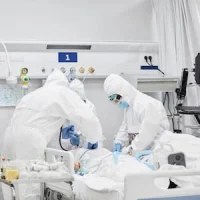Strong evidence supports use of noninvasive ventilation (NIV) for patients with respiratory distress from chronic obstructive pulmonary disease and heart failure – i.e., strong evidence conditions (SECs). A new study of patients hospitalised in California shows that most patients who received NIV did not have conditions with strong supporting evidence for its use, with wide institutional variation in patient selection for NIV.
"Surprisingly, we found that all patients, even those without an SEC, benefited from admission to hospitals with greater evidence-based utilisation of NIV, suggesting a 'hospital effect' that is synergistic with patient selection," the study authors write. "Future studies will be required to better understand how hospitals and physicians select patients to receive NIV and to identify specific practices that facilitate evidence-based use of NIV and improve NIV outcomes."
Despite potential harm from overuse of NIV among patients who are unlikely to benefit, use of NIV for conditions without strong supporting evidence has dramatically increased in the last two decades in the United States. However, whether clinical practice regarding optimal patient selection for the initiation of NIV at an institutional-level, and whether practice variation is associated with meaningful differences in outcomes, is unknown.
In this population-based study, researchers sought to characterise between-hospital variation in NIV utilisation for strong evidence-based conditions (COPD or HF) and evaluate associations between hospital rates of evidence-based NIV use and clinical outcomes. Using the California State Inpatient Database 2011, the research team identified adult patients who received NIV. Patients were considered to have an SEC for NIV if they had an acute exacerbation of COPD or heart failure. The team used multivariable hierarchical logistic regression to determine the association between hospital rates of NIV use for SECs and patient risk of NIV failure, i.e., need for invasive mechanical ventilation (IMV) after NIV.
The study's key findings include:
- Among 22,706 hospitalisations with NIV as the initial ventilatory strategy, 6,820 (30%) had SECs.
- Patients with SECs had lower risk of NIV failure than patients with weak evidence conditions (8.1 vs. 18.2%).
- Regardless of underlying diagnosis, patients admitted to hospitals with greater use of NIV for SECs had lower risk of NIV failure.
"While the etiology of increased mortality associated with NIV failure has not been fully elucidated, we speculate that patients who fail NIV may experience subtle but potentially rapid worsening (e.g., from aspiration or pooling of secretions) that may go unrecognised for a period of time. Additionally, recent work suggests that even with NIV, patients with significant respiratory distress still have significantly increased work of breathing as well as large swings in transpulmonary pressure that can contribute to worsening lung injury," the authors explain.
Another interesting finding is that even patients without an SEC benefited from admission to hospitals that used NIV more often for patients with SECs (Quartile 4 vs. Quartile 1 adjusted odds ratio for NIV failure = 0.68; 95% CI = 0.52–0.88).
"The beneficial effects of being admitted to a hospital with higher use of NIV for patients with strong evidence conditions persisted even in our subgroup analysis of patients without strong evidence conditions. For example, our observation would suggest that a patient with pneumonia who receives NIV would have improved outcomes at a hospital that tends to use NIV preferentially for patients with strong evidence conditions compared to hospitals with liberal use of NIV. This finding suggests a beneficial ‘hospital effect’ that has not previously been described," according to the authors.
Source: Annals of the American Thoracic Society
References:
Mehta, Anuj B. et al. (2017) Evidence-based Utilization of Noninvasive Ventilation and Patient Outcomes. ATS Journals. doi.org/10.1513/AnnalsATS.201703-208OC
Latest Articles
noninvasive ventilation, respiratory distress, strong evidence conditions
Strong evidence supports use of noninvasive ventilation (NIV) for patients with respiratory distress from chronic obstructive pulmonary disease and heart failure – i.e., strong evidence conditions (SECs). A new study of patients hospitalised in California










